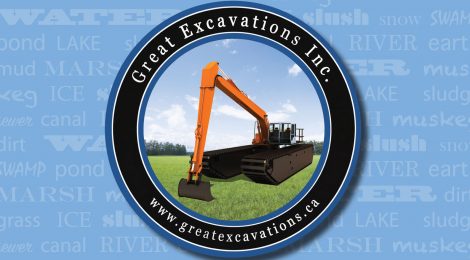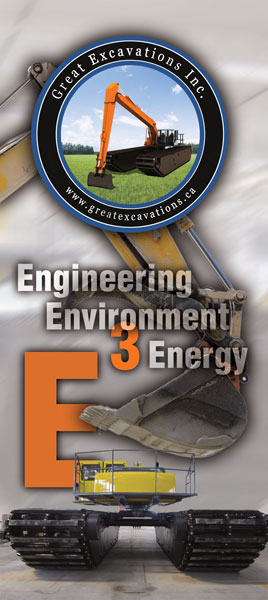
Canadian Land Reclamation Association Fall 2017 Great Excavations
SMART, EFFICIENT, CAPABLE
Amphibious (all-terrain) equipment for a changing world
By Mary Bird , Canadian Land Reclamation Association
Amphibious, all-terrain vehicles are building a Canadian comeback.
A mainstay of work on wet terrain around the world, from the swamps of Louisiana to the icy terrain of Siberia, these efficient, capable machines were developed for hard-to-access areas. Most impressive? They require minimal infrastructure.
“Our equipment is lighter, faster and more maneuverable than its predecessors,” says John Skierka, CEO of Great Excavations Inc., a service provider in environmental remediation and reclamation, as well as the energy, mining, agriculture and construction sectors. “Our pontoon-based undercarriages float, which means they support work on any terrain – they are the ultimate all-access vehicle.”
Great Excavations is notable for its use of adaptable equipment.
“We specialize in projects on wet terrain, from mud and muck to muskeg and ice, and everything in between,” says Skierka. “Our goal is to make amphibious machinery more accessible – and to prove its capabilities for work in environmentally sensitive areas.”
A 2016 Canada’s Oil Sands Innovation Alliance (COSIA) study evaluated amphibious vehicles for year-round restoration. The study concluded that “using these vehicles for caribou habitat restoration is first, and may be a game-changer in improving the pace and cost of restoration with minimal environmental impact.”
“Modern amphibious equipment is gaining a reputation for its flexibility on uncertain terrain, as well as its efficiency in linear restoration and deactivation,” explains Skierka. “Whereas other equipment may require significant support through building ice roads and using swamp mats – both of which come with their own environmental costs – an amphibious vehicle is able to access remote locations with minimal impact.”
Skierka says these machines can reach the boreal forest independently and work largely uninterrupted through the spring, summer and fall, increasing the amount of work done as well as the longevity of that work.
“Shorter, warmer winters are part of the inspiration for our manufacturing system,” says Amanda Butala, sales lead at Amphibious Equipment Solutions Inc. (AES), which builds excavators and carrier trucks. “Our machines can work year-round, but the greatest efficiencies are April through November, which basically doubles the work time of more traditional equipment.”
AES is known for tailoring machines to specific tasks, such as improving northern habitats through modifications to machines slated for linear deactivation.
“We needed a narrower machine that could traverse cut lines but still do the work of a traditional excavator while also floating, if required,” says Skierka. “Working with industry partners, we developed a telescopic undercarriage so the machines can traverse narrow corridors when needed, then expand to their full size while working.”
According to Butala, this type of innovation is key to building a market for these remarkable machines.
“Our investment in innovation is about building sensible solutions for industry,” says Butala. “The next step is making this equipment a must-have for remediation and restoration work.”
Skierka agrees.
“We already know our machines can do the work – and do it well,” says Skierka. “We know we have a minimal environmental footprint and excellent biosecurity compared to traditional methods. We know amphibious equipment reduces costs, time and effort. And we know our systems work.”
The challenge? Ensuring industry buy-in in a sector built on the winter work cycle.
“It’s time for change,” says Skierka. “We have a lot of work to do in the environmental sector, which is a key part of our business philosophy. But it’s also time to convince traditional industry that reducing environmental impact starts with making simple changes that provide value every day, such as floating machinery.”
For more on the benefits of amphibious equipment, check out:
http://www.cosia.ca/initiatives/land/amphibious-vehicles
http://www.cenovus.com/news/our-stories/amphibious-vehicles-offer-game-changing-solution-to-restore-land.html
